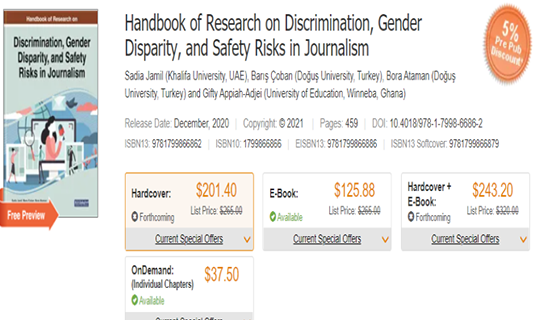
Media scholars call for safe and non-discriminatory environment in newsrooms
KATHMANDU: Scholars and media experts have shown their concerns to the growing cases of gender-based threats and discrimination that continue to characterize journalism across the world. They have provided their insights to promoting gender equality in journalism through studies carried out in 11 countries incorporating the level and nature of threats faced by journalists and gender discrimination in journalism.
The Handbook of Research on Discrimination, Gender Disparity, and Safety Risks in Journalism, published by IGI, Global emphasizes that working in a safe and non-discriminatory environment is the right of all journalists and regardless of their gender. The book edited by Sadia Jamil of Khalifa University, UAE, Barış Çoban and Bora Ataman of Doğuş University, Turkey and Gifty Appiah-Adjei, University of Education, Winneba, Ghana presents 20 chapters from 11 countries that include Philippines, Pakistan, Bangladesh, Nepal, India, Nigeria, Ghana, Rwanda, Venezuela, Georgia, and Bulgaria.
Media experts and scholars have asserted that women journalists are routinely sexualized, and their high visibility in television broadcasting—through explicit scrutiny of their bodies, hairstyles, clothing, and voices—is countered by their invisibility in management. Gendered double standards and a glass ceiling continue to bewilder the promotion of women to key decision-making and governance positions in print and broadcast news organizations in developed and developing countries both, the book disclosed.
The chapter on Gender Mainstreaming in the Media: The Issue of Professional and Workplace Safety of Women Journalists in Nepal, contributed by Laxman Datt Pant, renowned media expert and the Chairperson of Media Action Nepal reveals that women in media are more vulnerable to gender-based violence, which poses a serious threat to safety of women journalists in Nepal. Pant argued that despite Nepal’s laws guarantee press freedom and women’s equal rights, right to freedom of expression, equal work and wage through the constitution and commitments to several international human rights instruments, women journalists face multiple obstacles in journalism.

The concluding chapter has been written by the editors of the book. It offers recommendations about how to deal with the issues of discrimination, gender disparity and safety risks, and what could be the best practices to promote equal and safe working environments for both male and female journalists